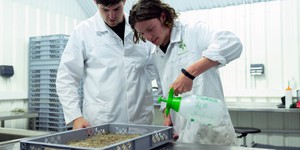Have Your Chips Lost Their Chomp? Understanding How Food Becomes Rancid
Abstract
You are looking under your bed for that video game you want to play, when you come across a real treasure—an open bag of potato chips that you forgot about! A crispy and salty potato chip is a tasty treat. But wait! This potato chip is not crisp and does not taste as great as it should. What happened? The chips have gone rancid! In this cooking and food science fair project, you will look into what factors turned your chips rancid.Summary
Michelle Maranowski, PhD, Science Buddies
- Scotch® is a registered trademark of 3M.
This science fair project is based on an oxidative rancidity project found at the Clemson University Food Sciences website.
- Clemson University, Department of Food Science and Human Nutrition. (n.d.). Oxidative Rancidity. Retrieved March 31, 2009.
Objective
To determine what factors cause potato chips to spoil and go rancid.
Introduction
Have you ever snuck a bite of food you've rediscovered from under your bed or between the couch cushions? Be careful, because food isn't good forever! When food spoils and goes bad, it's often described as rancid. Not only can eating rancid food taste bad, but a certain kind of rancidity can actually cause you to get sick, which is why people have developed many ways to prevent foods from spoiling, including smoking, salting, and fermentation. In modern times, we most often preserve foods by canning and refrigerating them. But why does food become rancid in the first place?
Fats or oils (also generally called fats) are added to foods, like crackers, cookies, and cakes, to improve the taste and feel (texture) of foods. Foods become rancid when there is a chemical change to the fats in the food. There are three types of rancidity: hydrolytic, oxidative, and ketonic. Hydrolytic rancidity (pronounced HY-droh-LIH-tik, derived from the Greek work for water, hydra) happens when there is water involved. Oils that are used for deep-frying become rancid faster because placing wet food in the heated frying oil introduces water. Oxidative rancidity occurs when the food (fat) is exposed to the oxygen in air. Oxidative rancidity happens in two steps. The first step is slow and happens when the fat in the food is exposed to several factors, including light, high temperatures, and salt. The second step is permanent and happens when oxygen interacts with the fat to create unstable molecules, which affect the taste. Ketonic rancidity (kee-TAH-nik) occurs when molds (a microscopic life form) weaken the fats.
In this cooking and food science fair project, you will investigate oxidative rancidity. Oxidative rancidity makes food taste bad, but it will not make you sick. You will expose potato chips and raisins to air and to light for increasing amounts of time and see if and when the chips and raisins become rancid. Time to get chomping—but don't eat all your specimens before the project is over!
Terms and Concepts
- Rancid
- Fats
- Hydrolytic rancidity
- Oxidative rancidity
- Molecule
- Ketonic rancidity
- Mold
Questions
- What are fats? Are fats good for you?
- How does the process of oxidative rancidity occur?
- How do food manufacturers prevent foods from going rancid?
Bibliography
This reference discusses rancidity:
- Lowe, B. (1937). Experimental Cookery from the Chemical and Physical Standpoint. Retrieved March 31, 2009.
This reference discusses the importance of and facts about food safety:
- North Carolina Department of Agriculture and Consumer Services. (n.d.). Kids World–Food Safety. Retrieved May 11, 2009.
For help creating graphs, try this website:
- National Center for Education Statistics. (n.d.). Create a Graph. Retrieved March 31, 2009.
Materials and Equipment
- Canning jars, 1-quart (qt.) size, clean and with the rings and lids (12)
- Aluminum foil (1 roll)
- Scotch® tape
- Potato chips with fat (3 large or family-size bags)
- Measuring cup, ¼-cup
- Raisins, (3 15-ounce [oz.] boxes)
- Permanent marker
- Masking tape
-
Volunteers (2, in addition to you)
- Note: The volunteers should be around the same age that you are and should be able to come over every 2 days for 2 weeks or you could take samples to school every 2 days for them to taste and rate.
- Lab notebook
- Optional: Graph paper
Experimental Procedure
- Cover the sides and the bottom of two of the canning jars with aluminum foil so that when the lid is screwed on, no light will enter the jars. You can use Scotch tape to securely attach the foil to the jars.
- Open the bags of potato chips and the boxes of raisins. Fill one of the foil-covered jars almost full with potato chips. Place ¼ cup of raisins in the other foil-covered jar. Label the jars with masking tape and a permanent marker, with the type of food and trial #, such as Potato Chips: Trial 1. Screw the lids tightly onto the jars so that no air can enter the jars.
- Now fill one of the uncovered jars almost full with potato chips and another uncovered jar with ¼ cup of raisins. Label these jars the same was as you did in step 2. Screw lids tightly onto both jars.
- Repeat steps 2–3 two additional times, labeling four jars for trial 2 and four jars for trial 3. You should now have 12 jars. Six jars should have potato chips in them and the other six should have raisins in them. Three of the potato chip jars should be covered with aluminum foil, as should be three of the raisin jars.
- Place the jars labeled for trial 1 on a windowsill or other well-lit spot. Make sure that the jars will not be disturbed wherever they are located. Note down the location of these four jars in your lab notebook, as well as the time and date when you placed the jars on the windowsill. Find two other windowsills or well-lit spots in your house. Put the four jars from trial 2 at one of the locations, and the four jars from trial 3 at the other location. Note down all locations, dates, and times in your lab notebook.
-
Keep the jars on the windowsills or well-lit spots for 2 weeks, but on the first day and every two days after that, open each jar so you and your two volunteers can sample the potato chips and the raisins. Each volunteer should only sample one piece of each. When you are finished, remember to tightly screw on the correct lid again. Try to pick the same time of day so roughly the same amount of time has passed between observations. In your lab notebook, describe the taste and whether or not the taste has changed, using the following rating system (try not to focus on the texture—just the taste):
- 5 - The potato chip/raisin tasted great, I really liked it.
- 4 - The potato chip/raisin tasted good.
- 3 - The potato chip/raisin tasted okay.
- 2 - The potato chip/raisin didn't taste good.
- 1 - The potato chip/raisin tasted awful, I wish I had never eaten it.
- Record your data in a table, like the one shown below. Construct a table like this in your lab notebook for each volunteer.
Volunteer 1's Data Table
| Jar and Food | Location | Day 1 Taste Rating | Day 3 Taste Rating | Day 5 Taste Rating | Day 7 Taste Rating | Day 9 Taste Rating | Day 11 Taste Rating | Day 13 Taste Rating | Day 15 Taste Rating |
| Foil-covered Jar with Potato Chips | |||||||||
| Uncovered Jar with Potato Chips | |||||||||
| Foil-covered Jar with Raisins | |||||||||
| Uncovered Jar with Raisins |
- Now it is time to analyze the data. Make a plot for each volunteer for each location. If you need help making plots, or would like to do your plots online, try using the following website: https://nces.ed.gov/nceskids/CreateAGraph/default.aspx. You can also make your plots by hand. You will have three sets of plots for each volunteer. One plot for each location. Label the y-axis Rating and label the x-axis Time after placing in light. You will plot all four jar and food data sets on the same plot.
- What do your results show? Did both raisins and potato chips become rancid? What did you discover as one of the key differences between raisins and potato chips? What is the difference in the amount of fat, protein, and carbohydrates (Hint: You can look on the boxes of each to find this information)?
Ask an Expert
Global Connections
The United Nations Sustainable Development Goals (UNSDGs) are a blueprint to achieve a better and more sustainable future for all.
Variations
- Are the textures—the crispness of the potato chips and chewiness of the raisins—affected in this science fair project? Do you see a visual difference in the chips and raisins between the beginning and the end of the science fair project?
- What is the effect of water on the potato chips and raisins? Investigate hydrolytic rancidity.
- What is the effect of temperature on the potato chips and raisins? Do the foods stay fresher if they are kept at cooler temperatures?
- Does age of the taster affect when things start to taste rancid? Will a younger person notice when food becomes rancid before an older person? Gather a group of 10 people, separate them by age, and perform the experiment.
- Does gender affect when things start to taste rancid? Gather a group of 10 people, separate them by gender, and do the experiment.
Careers
If you like this project, you might enjoy exploring these related careers:










